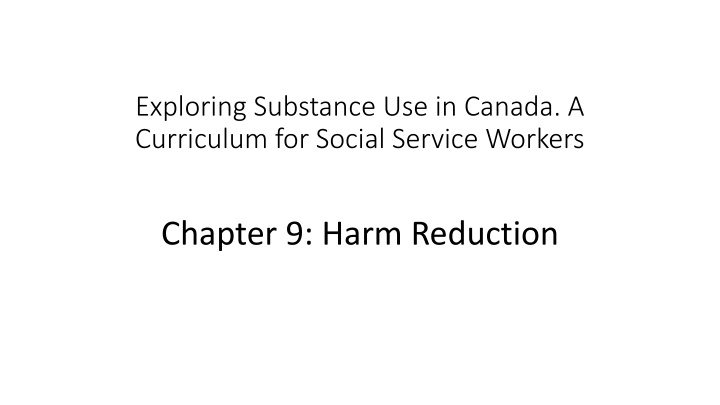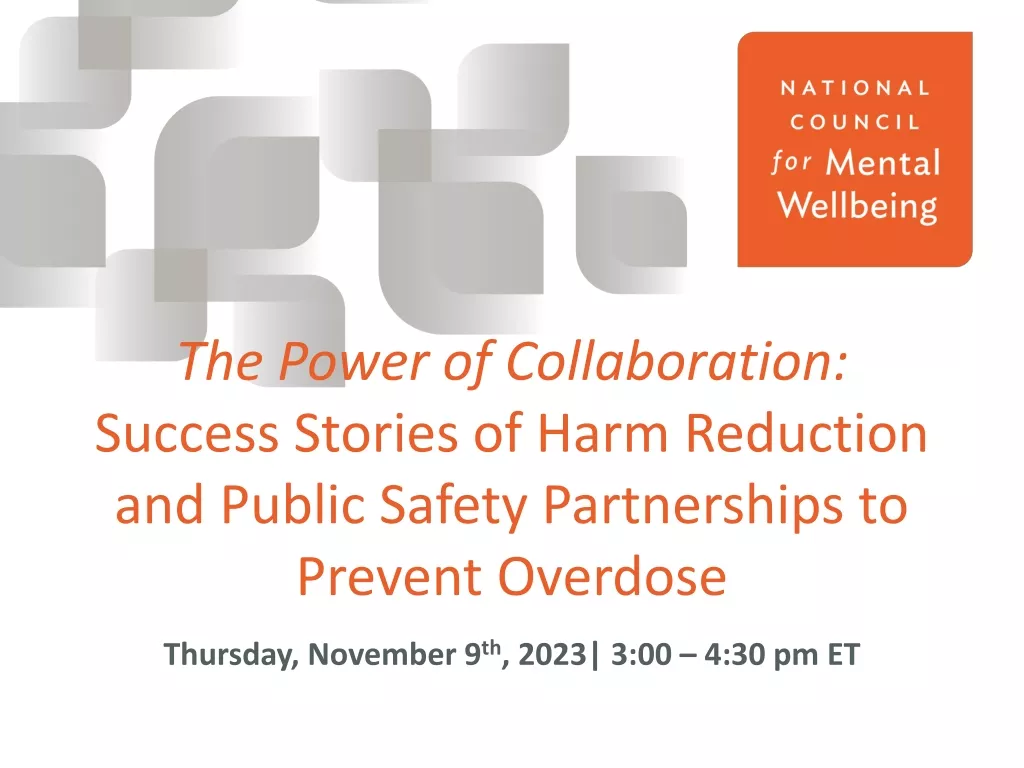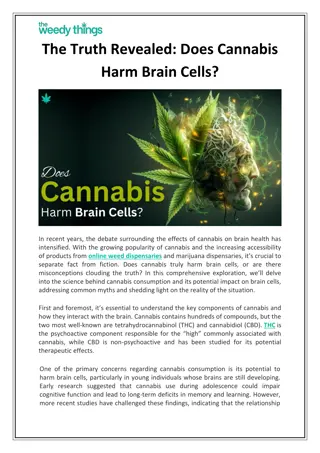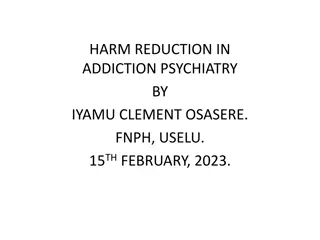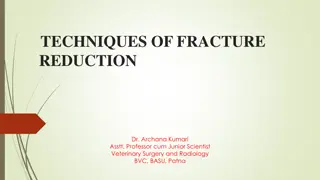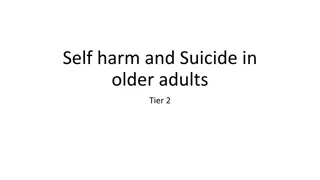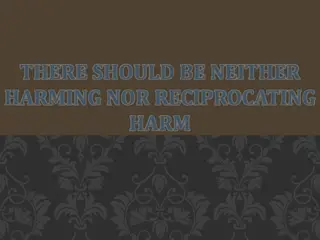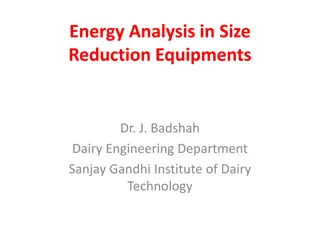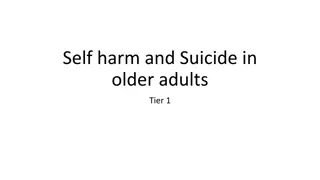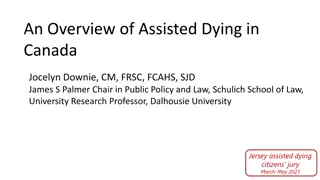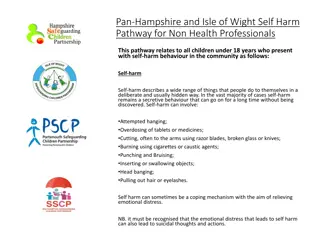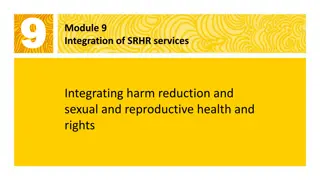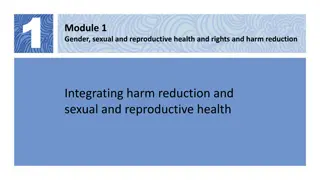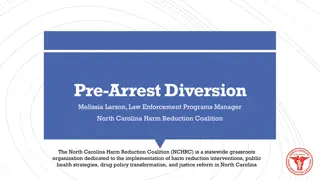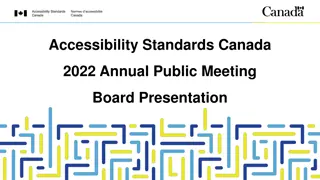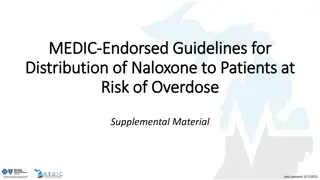Harm Reduction in Canada: Program Overview
Harm reduction in Canada aims to minimize the risks associated with substance use through evidence-based practices. This approach focuses on reducing health, social, and economic harms linked to psychoactive substances, benefiting individuals, communities, and society. Harm reduction programs in Canada vary in consistency due to dependence on community-based agencies and government funding.
Download Presentation

Please find below an Image/Link to download the presentation.
The content on the website is provided AS IS for your information and personal use only. It may not be sold, licensed, or shared on other websites without obtaining consent from the author.If you encounter any issues during the download, it is possible that the publisher has removed the file from their server.
You are allowed to download the files provided on this website for personal or commercial use, subject to the condition that they are used lawfully. All files are the property of their respective owners.
The content on the website is provided AS IS for your information and personal use only. It may not be sold, licensed, or shared on other websites without obtaining consent from the author.
E N D
Presentation Transcript
Exploring Substance Use in Canada. A Curriculum for Social Service Workers Chapter 9: Harm Reduction
1.Describe harm reduction 2.Understand the role of harm reduction programs 3.Summarize harm reduction practices in Canada 4.Identify harm reduction programs in Nova Scotia Learning Objectives:
What is harm reduction?
Harm reduction is minimizing the risks of what can be a risky behaviour. This Photo by Unknown Author is licensed under CC BY-NC-ND
In the world of substance use Using clean syringes, distilled water, fresh cottons, cookers, and pipes, as well as disposable mouthpieces, help individuals use substances safely. This is also harm reduction. The risky behaviour can be immediate or long term and harm reduction is a critical component of a robust drug policy in any community, province, or country. Harm reduction comes from a concern for health, recognizing the complexity of substance use.
Providing a low to no barrier service is critical for a successful harm reduction program. Canada's support for low barrier harm reduction services has been growing steadily since the 1980's and "national and international support for harm reduction is growing while almost all the major UN organizations responsible for drug policy now support harm reduction (Wodak & McLeod, 2008, p. 81). Harm Reduction is becoming more understood
https://www.youtube.com/watch?v=KY7_ytZDlN8&t=1s CAMH, 2010
What is harm reduction? Harm reduction, based on the definition by the International Harm Reduction Association (2021) is stated as policies, programmes and projects that aim to reduce the health, social and economic harms associated with the use of psychoactive substances. It is an evidence-based and cost-effective approach bringing benefits to the individual, community and society (para. 1). In Canada, harm reduction programs are heavily dependent on community-based agencies and reliant on provincial and federal government funding for service provision, so lack consistency. In 2015, "only two jurisdictions in Canada had current provincial-level, stand-alone harm reduction policies" (Hyshka et al., 2017, para. 3), which confirms what many individuals working in harm reduction in Canada have suggested, that a harm reduction philosophy is not embedded in policy or funding at any governmental level.
Why is harm reduction important? Effective harm reduction programs seek to serve some of the most marginalized individuals in Canada. As we have explored, substance use is frequently misunderstood and stigmatized; therefore it stands to reason that harm reduction strategies that help support individuals who use substances would be concurrently maligned and perhaps not overtly supported in Canada. Part of your work, as Social Service workers, is to address the stigma associated with not only substance abuse, but harm reduction. How will you do this?
Harm Reduction in Canada Harm reduction access in Canada depends on the area in which one lives, for example, living in an urban area increase the chances to access harm reduction programs. Research suggests harm reduction services in Canada lack consistency as they are heavily dependent on the provincial governments; organizations lack continuous funding, must participate in a difficult application process for funds, and provinces and territories share different values when it comes to harm reduction (Hyshka et al., 2017; Caveleiri et al., 2012).
Managed Alcohol Programs People with severe alcohol dependence who engage in unsafe consumption (amount and consumption of non-beverage alcohol, like hand sanitizer or mouthwash) and a lack of housing are vulnerable to multiple harms (Pauly et al., 2013). Managed Alcohol Programs aim to reduce the harms to individuals who are at risk by providing a safe source of alcohol coupled with services which may include housing, counselling, healthcare, and peer support. "MAPs are harm reduction programs intended to reduce harms of high-risk drinking or severe alcohol use disorder often coupled with ongoing experiences of homelessness or poverty" (Canadian Institute for Substance Use Research, n.d., p. 2). There are many different MAP programs in Canada "including community day programs, residential models located in shelters, transitional and permanent housing and hospital-based programs" (Canadian Institute for Substance Use Research, n.d., p. 2). Every program has different criteria, some address intersectional issues and are gender, race and age specific; nonetheless, all programs have the common goal of preserving dignity and reducing harms of drinking while increasing access to housing, health services, and cultural connections. MAPs have become an important part of harm reduction in Canada.
Heroin Assisted Treatment (HAT) The first HAT in Canada began in 2005, North America Opiate Medication Initiative (NAOMI) which ran simultaneously in Vancouver and Montreal from 2005-2008 (Oviedo-Joekes et al., 2008). Many participants were living in unstable housing and over 90% of participants had been engaged in some criminal activity during their lifetime (Oviedo-Joekes et al., 2008). Participants were given daily doses of prescription opiates and services to support their other health needs, a comprehensive range of psychosocial and primary care services (Oviedo-Joekes et al., 2008). There was also a control group which received Methadone Maintenance Therapy. The results showed a reduction in average spending on substances, a reduction in illicit-drug use or other illegal activities, an improvement in medical and psychiatric status, improvement in employment satisfaction, and family and social relations (Berridge, 2009). There was advocacy to continue the trial for compassionate reasons; however, this was denied by the Canadian Government. "After a year of receiving HAT, participants entered a three-month transition when they were offered a range of traditional treatments, including MMT and detox. After the three-month transitional period, no further treatment or supports were offered" (The NAOMI Patients Association & Susan Boyd, 2012, p. 20).
Syringe Distribution Programs Syringe distribution programs offer clean syringes, alcohol swabs, cookers, water, cottons, all the materials one would need to inject more safely. They also provide safer injection information including safer injection places on the body, vein care, and when to get help. They provide condoms and safer sex information to reduce risks of sexually transmitted infections. They provide a safe space to build relationships, and for those who want to move towards a reduction in use or abstinence, staff at SDP can make referrals to various treatment options. Being a first point of contact has a tremendous amount of responsibility; Social Service workers should have a good understanding of services in their community.
Safe Injection Sites (SIS) Also known as safe consumption sites (SCS), these facilities have been an important part of the harm reduction landscape, particularly in Western Canada since the advent of the HIV crisis and most recently the ongoing public health crisis of opioid overdoses and death (Government of Canada, 2021). SIS are places where people can more safely inject substances using clean equipment under the supervision of medically trained personnel which reduces the risk of overdose and blood borne illnesses. It also allows individuals who may not have had any positive connection to healthcare or other support services to build relationships if they choose. Most SIS have expanded their mandate to include various forms of consumption. What if substance use is hidden? In rural areas substance use is not always seen in public, which may challenge communities to acknowledge the substance use of its residents.
Beyond the services provided People who use substances are at risk when using in a public area; these risks include being caught by police, being physically or sexually assaulted, or robbed (Green et al., 2004). Having a safe place to go reduces those risks. One of the ways SIS are helping to reduce the risk of accidental overdose is using testing kits. People can bring in their substance, have it tested, get information on what is in their substance, which helps them make a more-informed decision about what they use (Maghsoudi et al., 2021). This is a necessity in Canada when substances are bought and sold in the black market. Without regulation, there is risk when you purchase a substance. SIS provide testing kits to prevent overdose and illness.
https://www.youtube.com/watch?v=7gIyBMt2BEk (National Film Board, 2017).
Overdose Prevention Sites Overdose Prevention Sites (OPSs) developed in a similar way as supervised injection sites, from grassroots activism by people who use substances pushing the agenda (Pauly et al., 2020). They helped create pop-up unsanctioned sites in a few locations in BC (Pauly et al., 2020). In 2017, Health Canada announced a new strategy to address the opioid crisis with the exemptions of OPS's. The OPS applies for an exemption under Health Canada, then applies to the province for a three to six month exemption under the Controlled Drug & Substances Act. The OPS can address an "at-risk" community (an area where there is high substance use and overdose death) by providing space (sometimes a tent, sometimes a store front location) for people to consume their substance of choice (including inhalation) with sterile equipment, in settings where they can be observed, and others can quickly intervene in the event of an overdose.
OPS are pop ups OPS are not required to have health care professionals on staff and are considered "pop- up" as they are a mobile response to overdose prevention. In September of 2019, Atlantic Canada s first government approved OPS opened in the basement of Direction 180, a Methadone Maintenance Program in Halifax, due to the lobbying efforts of numerous harm reduction agencies in Nova Scotia. OPS's have made an impact across Canada; nonetheless, there is limited research on OPSs (Pauly et al., 2020). OPS are a very low-barrier harm reduction service.
Naloxone As of October 23, 2021, 33 Nova Scotian's lost their life to overdose (Government of Canada, 2021). One way to prevent overdose deaths, as part of a comprehensive harm reduction strategy, is to ensure individuals and communities have access to naloxone, an opioid antagonist to an opioid overdose. In 2017, the Nova Scotia Department of Health and Wellness recognized individuals using opioids and their family and peer groups must have access to naloxone and created the Nova Scotia Take Home Naloxone Program (Government of Nova Scotia, 2021). The program "provides opioid overdose prevention/naloxone administration training and free take home naloxone kits to Nova Scotians at risk of an opioid overdose and those who are most likely to witness and respond to an opioid overdose" (Government of Nova Scotia, 2021).
https://www.youtube.com/watch?v=KbUwb-pszW4 (Canadian Association of People Who Use Drugs, 2021)
Gender and harm reduction Harm reduction programs that do not take into account gender fail to address the systemic and everyday racialized and gendered discrimination, stigma, and violence that can be experienced by women in an all-gender harm reduction service, which limits some women's access (Boyd et al., 2020). While all genders who use substances can experience the socioeconomic, physical and mental health impacts of substance abuse, women are at a greater disadvantage because of systemic inequity (Ettorre, 2004). This means women have less employment opportunities and earn less, have more health risks, and have barriers to education (Canadian Women s Foundation, 2020). Using intersectionality we can examine the different risks, including pregnancy, sexualized violence, violence, sex work and human trafficking, recognizing not all women have the same experiences.
Areas that must be addressed
Self Care Please complete the self care activities in chapter 9 and report back next class.
References Berridge, V. (2009). Heroin prescription and history. The New England Journal of Medicine, 361, 820-821. https://psycnet.apa.org/doi/10.1056/NEJMe0904243 Boyd, J., Lavalley, J., Czechaczek, S., Mayer, S., Kerr, T., Maher, L., & McNeil, R. (2020). Bed Bugs and Beyond : An ethnographic analysis of North America's first women-only supervised drug consumption site. International Journal of Drug Policy, 78. https://doi.org/10.1016/j.drugpo.2020.102733. Canadian Association of People who Use Drugs. (2021). How to spot someone so they never use alone. [Video]. Youtube. https://www.youtube.com/watch?time_continue=3&v=KbUwb- pszW4&feature=emb_logo Canadian Institute for Substance Use Research. (n.d.). Scale up of managed alcohol programs. Bulletin #20. 1-4. https://www.uvic.ca/research/centres/cisur/assets/docs/bulletin-20- scale-up-of-maps.pdf Canadian Institute for Substance Use Research. (2021). Overview of Managed Alcohol Program (MAP) sites in Canada (and beyond). https://www.uvic.ca/research/centres/cisur/assets/docs/resource-overview-of-MAP-sites-in-Canada.pdf Cavalieri, W., & Riley D (2012). Harm reduction in Canada: The many faces of regression. In Pates & D. Riley (Eds.), Harm reduction in substance use and high risk behaviour: international policy and practice (pp. 392 394). Wiley-Blackwell. Centre for Addiction and Mental Health. (2010, Dec. 13). Harm reduction. [Video]. Youtube. https://www.youtube.com/watch?v=KY7_ytZDlN8&t=1s Government of Canada. (2021, Sept. 22). Opioid- and stimulant-related harms in Canada. https://health-infobase.canada.ca/substance-related-harms/opioids-stimulants/ Government of Canada. (2021, Nov. 11). Supervised consumption sites: Status of applications. https://www.canada.ca/en/health-canada/services/substance-use/supervised- consumption-sites/status-application.html Government of Nova Scotia. (2021). Nova Scotia take home naloxone program. http://www.nsnaloxone.com/about-the-program.html Green, T. C., Hankins, C. A., Palmer, D., Boivin, J. F., & Platt, R. (2004). My place, your place or a safer place: The intention among Montreal injecting drug users to use SIF. Canadian Journal of Public Health, 95(2),110-114. https://www.jstor.org/stable/41994109 Hyshka, E., Anderson-Baron, J., Karekezi, K., Belle-Isle L., Elliott, R., Pauly, B., Strike, C., Asbridge, M., Dell, C., McBride, K., Hathaway, A., & Wild, T. C. (2017). Harm reduction in name, but not substance: a comparative analysis of current Canadian provincial and territorial policy frameworks. Harm Reduction Journal, 14(1), 50. https://doi.org/10.1186/s12954-017-0177-7 International Harm Reduction Association. (2010). What is harm reduction? A position statement from the International Harm Reduction Association. https://www.hri.global/files/2010/08/10/Briefing_What_is_HR_English.pdf Maghsoudi, N., Tanguay, J., Scarfone, K., Rammohan, I., Ziegler, C., Werb, D., & Scheim, A. (2021). The implementation of drug checking services for people who use drugs: A systematic review. Qeios. https://doi.org/10.32388/TXE86U The NAOMI Patients Association & Boyd, S. (2012). NAOMI research survivors; experiences and recommendations. https://drugpolicy.ca/wp- content/uploads/2012/03/NPAreportMarch5-12.pdf National Film Board of Canada (2017, May 26). Inside Insite. [Video]. Youtube. https://www.youtube.com/watch?v=7gIyBMt2BEk Oviedo-Joekes, E., Nosyk, B., Brissette, S., Chettiar, J., Schneeberger, P., Marsh, D. C., Krausz, M., Anis, A., & Schechter, M. T. (2008). The North American Opiate Medication Initiative (NAOMI): Profile of participants in North America's first trial of heroin-assisted treatment. Journal of Urban Health: Bulletin of the New York Academy of Medicine, 85(6), 812 825. https://doi.org/10.1007/s11524-008-9312-9 Pauly, B., Wallace, B., Pagan, F., Phillips, J., Wilson, M., Hobbs, H., & Connolly, J. (2020). Impact of overdose prevention sites during a public health emergency in Victoria, Canada. PLoS One, 15(5). https://doi.org/10.1371/journal.pone.0229208 Wodak, A., & McLeod, L. (2008). The role of harm reduction in controlling HIV among injecting drug users. AIDS, 22, 81 92. https://doi.org/10.1097/01.aids.0000327439.20914.33010
